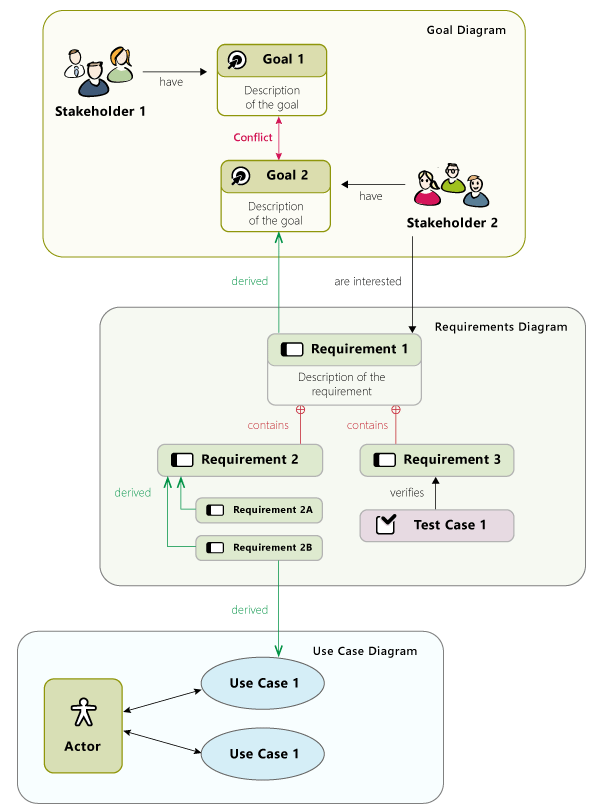The development of requirements engineering (RE) is influenced by various factors. First and foremost: advanced digitization with its technological innovations. Larger systems also demand the handling of increasingly complex requirements. Hardly any technical product today functions without software. Many devices can now be controlled via an app, for example. As a result, agile processes are increasingly establishing themselves in areas that are not primarily designed for software development.
Modern RE has to be adaptable in order to be successful in a fast-moving project environment with frequently upcoming change requests. Stakeholder needs must also be considered throughout the process. In order to maintain an overview in the face of this complexity, methods and technologies are increasingly being used to help prioritize and reuse requirements, highlight interrelationships and dependencies, and ensure traceability.
In the following, we present some ongoing trends in requirements engineering and then provide recommendations on how your company remains competitive.
The Integration of Requirements Modeling in the RE Process
Agile methods such as Scrum and Kanban are already an integral part of our everyday work, but requirements modeling is also becoming increasingly important. Modeling in the requirements engineering process plays a crucial role in the successful development of software projects.
By creating models, complex requirements and system interrelationships can be represented in an understandable, clear and structured way. The models serve as a bridge between stakeholders and developers by representing the requirements in visual form. This reduces misunderstandings and communication difficulties and creates a common understanding of the system being developed. In addition, models offer the possibility of systematically analyzing, validating and verifying requirements. In this way, contradictions, gaps or misinterpretations can be recognized and corrected at an early stage, which ultimately contributes to higher product quality and more efficient development.
objectiF RM and RPM offer many options for visualizing desired relationships with the help of diagrams. All of the following diagrams are directly integrated into the products and are the optimal complement to Kanban Boards and Backlogs.
The central element of the system context diagram is the system or the product in development. A complete system context provides a quick overview and optimal conditions for complete requirements. The system context diagram can also serve as a starting point for creating further models and diagrams.
A well set up target diagram already recognizes contradictions and overlaps in the interaction of the individual targets, which can then be resolved at an early stage. With objectiF RM and RPM, conflict relationships can be recognized at a glance and dependencies between goals are highlighted. With the goal diagram, you always have an overview of the stakeholders’ interests and can also adjust prioritizations during the course of the project.

In objectiF RM and RPM, you can display all project-relevant requirements in a requirements diagram. The relationships between the requirements and the stakeholders additionally create a comprehensible overall picture. Decisive aspects of the development process and special features of the system are thus clearly recognizable.
By integrating use case diagrams, you get different perspectives on your system and can look at it from the user’s point of view. With objectiF RM and RPM you can display all the relationships between use cases and make relationships between actors visible. You can add extension points to the individual use cases if its description needs to be extended. Further requirements can be derived from this.
The block diagrams of SysML offer significant benefits in RE by visually representing the structure and relationships of system components. This clear and graphical representation allows requirements and their relationships to be better understood, communicated, and analyzed. They promote a common understanding among all project participants and help to identify and clarify misinterpretations and ambiguities in the requirements at an early stage. For software development projects, class diagrams are also available for modeling software design.
During every step of your requirements engineering process within our products, the diagrams are available to you. With objectiF RM and RPM, you have everything clearly integrated in one tool and ready for everyone to access.
Generative Artificial Intelligence in Requirements Engineering
In the fast changing digital world, artificial intelligence (AI) has brought about profound changes. Generative AI in particular will have an immense impact in the field of requirements engineering (RE).
Capturing, analyzing and managing requirements will benefit enormously from the use of generative AI. In larger projects, thousands of requirements can quickly arise. With the help of artificial intelligence, these can be automatically classified and prioritized. Generative models can also help to identify ambiguities, conflicts, redundancies or incompleteness in the requirements and generate suggestions for solving these problems. This topic is also very exciting for us, which is why we have already highlighted the detection of similarities by an AI in this blog post.
Requirements could be generated from defined goals and recorded use cases with the help of artificial intelligence and then refined. We aim to implement this function in our tools in the future and are already working on it. The generation of test cases and the creation of documentation according to industry standards will also be increasingly supported by AI models.
Thus, incorporating generative AI into the RE process can significantly increase efficiency, reduce human error, and ensure more consistent quality in requirements generation. As AI models continue to learn and improve, this benefit will continue to grow over time.
Adaptable tools for complex requirements and systems
Products, systems, requirements – everything is becoming more complex. Unclear lists of requirements and frequent jumping back and forth between tables, programs and graphics make further development difficult. The future of requirements engineering must be tool-supported in order to maintain an overview. Companies will have to invest in manageable and yet individually adaptable tools in order to be able to organize the increasingly complex requirements and complete successful projects in the long run.
In objectiF RM and RPM, you can always see which results are affected by changes to requirements and trace which employee made them. Individual configuration and traceability are the hallmarks of our products. You can adapt standardized structures and workflows to your needs, thereby standardizing processes for all project participants.
Increase your competitiveness with efficient requirements engineering
The trend continues to move toward combining agile RE methods with requirements modeling to efficiently capture and represent rapidly changing requirements. By modeling the systems and their use cases, a common understanding can be created and potential misunderstandings and contradictions can be uncovered early on.
Requirements management is becoming increasingly complex with the new developments in digitization. Companies should not shy away from investing resources in more complex RE tools. This applies both to investments in the training and further education of employees and to tools that can facilitate communication, documentation and analysis of the entire RE process.
In the context of requirements engineering, this means for you: If you focus on agile procedures, stakeholder needs, tool integration and the continuous further development of your RE process, you can remain competitive in your industry in the future. Take advantage of high-quality requirements management to bring the products your stakeholders want to market in a targeted and tailored manner.
With a tool-supported RE process, you’ll benefit holistically in the way you work – from modeling to traceability to AI-powered capabilities. If you would like to learn more about these features of our products objectiF RM and RPM, we recommend our Download Center with whitepapers about our products and other topics related to requirements engineering, agile processes and multi-project management.

